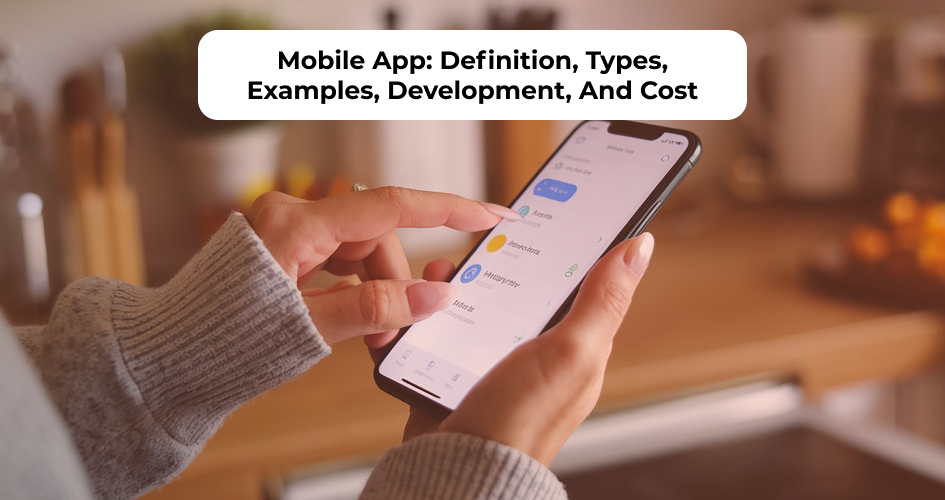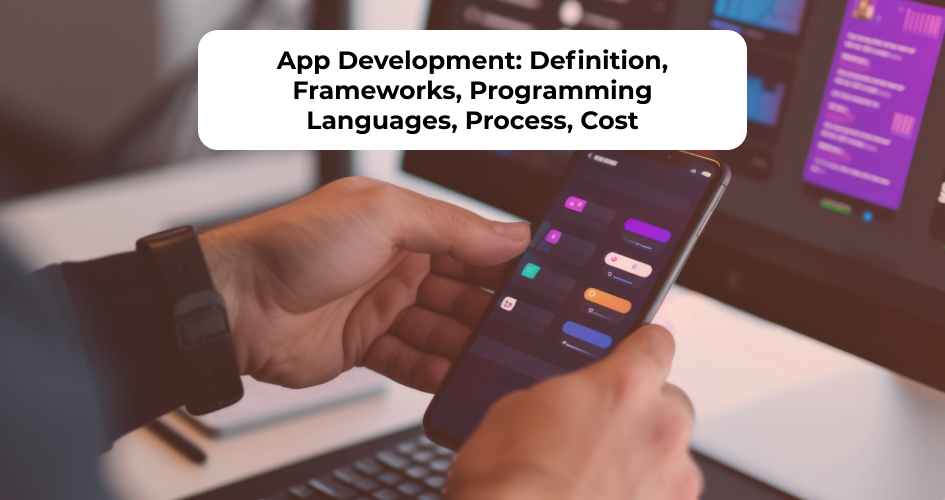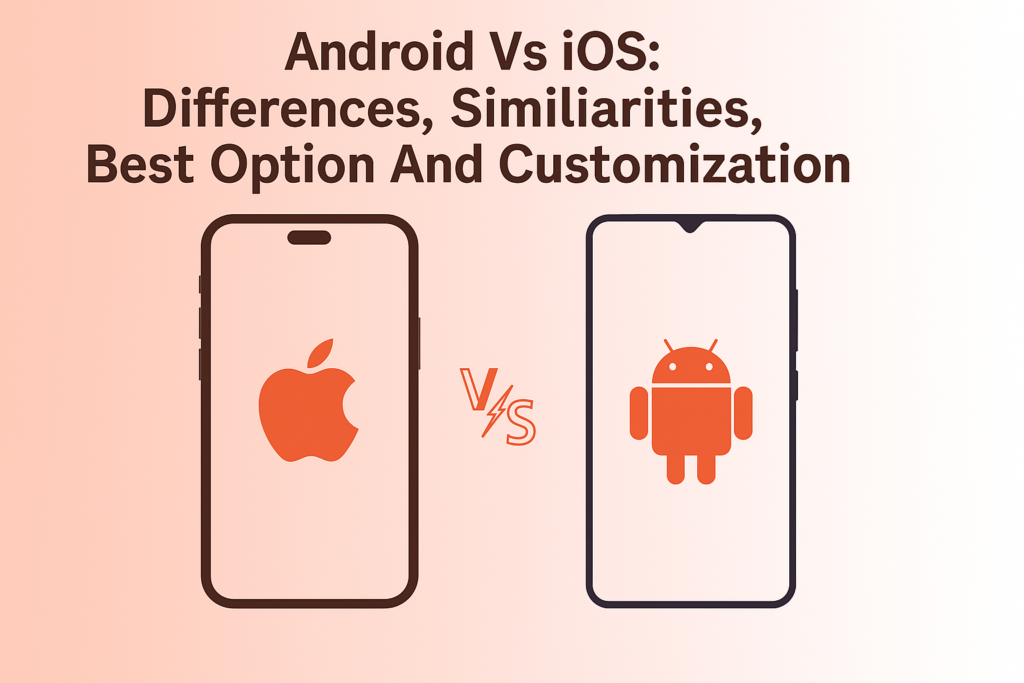An app can be developed for anything you can think of, from small business apps to eCommerce, health, communication, and dating apps.
Developing a mobile app can seem like a daunting task!
There are so many considerations to think about before creating an app – visual design, UX/UI, coding, and finding the right developer – that it may seem overwhelming.
But never fear!
In this blog, we’ll walk through the process of creating an app from scratch, step-by-step.
Without any further ado, let’s get started to understand how to create an app.
How to Make an App: 3 Phases to Consider
App development can certainly prove to be a profitable choice, provided you are ready to go through the three phases- product ideation, app development, and post-launch.
A typical app development process will have the following:
Phase 1: Market Research and Product Ideation
Like any other product you create, you must do a thorough market survey and check if a similar app(s) exists.
There are high chance that the kind of mobile app you are creating is readily available.
Such information is useful to determine value propositions and offer your exclusive USP.
Also, before dwelling on building mobile apps, try analyzing how the other apps are doing in the market and what can you do to make an app that is better than the existing ones.
First thing first — at the ideation stage knowing your customer persona and competitors is more important than acquiring knowledge on how to make an app.
1. Conduct market research
a. Understanding Target Audience
Knowing about the other apps would bring another aspect of app development – identifying and understanding the target audience.
Do not start to create your app blindly; instead, dig deeply and check the app concept’s competition.
Once you can get flattened and give up, or two, you can test the competition and boost your app.
Most businesses prefer the latter.
Start by creating demographics of who are likely to consume your app and identify the audience that helps define marketing strategy.
b. Know your Competition
Your research needs to change some focus after reading and analyzing the competition.
The question of whether your application is a genuinely workable idea?
Here you will look at restrictions on copyright and possible technical retention.
This is important because, in the long run, it will save you money.
The best question to ask apart from how to create an app is how to build one that your customers would like to use.
For an ideal app, you must add the right features, which fit best for your app and support users in the best way possible.
This depends a lot on why you are building an app.
If your aim is different than your competitors, go with what you feel is right to provide within the app.
2. Building Wireframe and Feature Finalization
When people first create a mobile app, they are inclined to incorporate any cool feature they can think of.
Sadly, this seldom translates into a good user experience.
First off, too many features can make your users overwhelm and hamper the app’s performance.
Second, you want to concentrate on improving your core user interface instead of deploying any poorly developed functionality when you are first released.
This is why wireframing an app is critical to defining the work scope involved during the initial release.
Image Source: Unsplash
Then evaluate the functionality of your app and work on making your interactions even more enjoyable and intuitive.
There’s always a window for you to add or remove features once you move beyond the fundamental concern of creating an app.
Because you will need to deliver the new update, keep in mind your value proposition of features when you first launch it.
A wireframe will only help designers navigate the buttons, touchpoints, and action items of an app.
It can largely influence the way your customers engage with the mobile app.
3. Product monetization
There are multiple ways to make money from the app you plan to launch.
Monetizing a mobile app totally depends on the Goal — why are you creating an app.
Some well-known ways to earn money from mobile apps are as follows:
- Incorporating Ads: This is possibly the most popular method of monetizing applications. Most applications contain ads, some delicately inserted into the interface and others are blatantly plastered in the store.
- Advertising: You can use your app to build a mailing list by forcing users to create an account and consent to promotional emails. This mailing list will then be connected to your other services and offers to upsell the other stuff.
- Pay and Use. Many applications provide limited trials with paid versions locked. For instance, Netflix gives a one-month free trial to new users who start charging a monthly subscription. Users can use the free version of the app (often with lots of publications) or pay without restriction to unlock a clean, complete, and better version of the app like Spotify Premium.
- In-app purchases. You can have the users pay for additional features, in-game currency, or other content in-app purchases most popular in mobile gaming.
- Hybrid. Naturally, there is nothing to suggest that these monetization strategies cannot be mixed. Therefore, you have your app developer help you blend in the best of the methods mentioned here for generating app revenue.
4. Who will build the App?
There is a constant dilemma
Should I outsource the app development or should I have an in-house team?
Well, if you consider it as a one-time development and recurrent update project, then hiring a full time, on-site developers may prove too costly and time-consuming.
Let’s have a quick look at both so you can take a wise call.
Source: Pexels
Where to create a Mobile app? Outsourcing or In-House?
A lot of variables come to play prior to making a decision.
Most of these will be about the app budget, timeline, technical specifications, and whether you want to build on iOS, Android, or a cross-platform app.
Before even being able to pick up the best option, make sure you have validated the concept for the mobile app that you shared with several other founders and app professionals.
3 Top reasons why you should go for an in-house app development
- More Brand & industry knowledge compare to outsourcing which can be time-consuming to better the learning curve
- Processes move faster with a clear hierarchical setup
- Flexible revisions and easy to fend against the delayed modifications and process engineering
When you work with professional mobile app developers, you have a typical set budget that may well come with some constraints.
You’re allowed a certain number of revisions and rounds of feedback at each step of the process.
It is not easy to hire a great talent who knows how to make an app.
It is more difficult to retain the right talent once you find it because it is a competitive market.
It is increasingly difficult to find eligible applicants to fill vacancies globally.
This also leads companies with such skills, such as software developers, regardless of whether or not there is a role for them.
It is better to have outsourced the key app development tasks to mobile application developers in such cases.
Here is why you should outsource the mobile app development
1. Bank on the team chemistry that the app developers breed in-house.
Hiring them will also give you an estimate of how much it cost to build an app.
On the contrary, you can have to give your in-house team time to come up with new team dynamics and the expenses are dynamic.
2. You can leverage the extensive app experience as most developers are dedicated to the core development process itself compared to having a mix of backgrounds with your on-site teams.
Once you plan your mobile app, make sure you move it to the next phase quickly since the idea is your biggest asset.
You don’t want to wait only to find another player in the market who has implemented the same idea.
Have a team in place to quickly start the app development process.
As you understood the ideation phase, now let’s move to the core phase where you will learn how to create an app and how much does it cost to build an app.
Phase 2: App Development
1. UI/UX
The two key elements of app development that can define its success or failure are User Interface and User Experience (UI/UX).
The interface has much to do with the wireframe as it defines the cohesiveness of all the app elements combined that can drive an ideal User Experience.
Many applications are available on the marketplace, with businesses now knowing how to create an app, enabling seamless UI/UX designs to strengthen brand performance and conversion rates.
Balancing the app UI/UX will also help you get organic traffic and help retain users by improving app stickiness.
Image source: Pexels
For those of you looking to penetrate deeper markets will need to hire UI designers to help users enjoy things they do with the app as feedback from testers is implemented in the design process.
If there is one answer to how to make an app that appeals to users, then it all boils down to designing the whole user journey — screen by screen.
This does not mean designing lovely app screens — you map the wireframes to understand how the app functions.
Testing UX should include tracing the entire user journey that enables redesigning wireframes for a more refined UX.
Ensure creating an app development roadmap before investing additional capital in design since it is a powerful UI that promotes UX beneficial to the app.
2. Choice of a mobile app platform
There are three platforms to target when creating a mobile app by keeping the prospective mobile app users in mind.
a. Native iOS apps:
Most of the Apple App Store deals are written as the IDE of choice in Objective-C and Xcode (only available on macOS).
Both Xcode and iOS SDKs are available free of charge for application development, but you will need a relevant developer account to publish in the App Store.
These applications need to be top-notch as the Apple Store act as a gatekeeper for all the iOS apps.
Therefore, it demands higher standards at launch and also a commitment to keep it consistent.
b. Native android apps:
Android app development usually relies on Java.
Also, the developers tend to integrate the Eclipse IDE and Kotlin for the Android platform at some point.
Alternatively, you can use the official IDE Android Studio.
Android applications can quickly be built in any ecosystem, including Windows, Mac, and Linux.
You can use all development tools free of charge when publishing them on the Google Play store, an open platform, providing an ideal marketplace for apps to compete fairly.
c. Cross-platform apps:
With a plethora of cross-platform frameworks in the market (Flutter, Xamarin, React Native, etc.) it becomes difficult to pick the right one for running an app on both platforms with a single code base.
But, if you are looking for faster development with a better UI then go with flutter app development.
Intelivita is already providing businesses with a dedicated development team for flutter app development to unlock the true potential of your cross-platform apps.
3. Developing the MVP
The idea behind creating a Minimal Viable Product (MVP) is to have experience with the app by yourself and other stakeholders.
It forces you to think about your app’s most important features before you launch in the open market while also gauging how much it cost to build an app.
This is your time to gauge the app’s value and define the scope of improvement if any.
Remember, the app development process is virtually unending.
During the building phase, it is possible to distract and lose sight of your objectives.
But, instead of seeing it from the outside, make sure you understand the aesthetics behind adjustments within the scope of MVP.
Let’s assume that your MVP is an application that allows two users to send each other messages.
Now, you can’t start creating a video chat feature, setting the font settings, uploading images, or changing the app’s background color.
These are the modifications you will anyway incorporate before the launch.
Know the analogy of your mobile app like a house before you even start to address the concern of making a mobile app.
It’s just the pillars and walls.
You can dig in deeper once the fundamental functions are well set and match.
Build your Startups MVP idea with Intelivita — Contact us now!
4. Quality assurance
Unlike you cracking the finances to determine how much it costs to build an app, the quality assurance process is bottom top.
The app framework needs to be reviewed on existing mobile platforms.
There are several different ways to use the app so that the quality assurance team must check everything from scratch.
Know if your cross-platform app is device agnostic, meaning it works like a charm across iPhones, iPads, Android devices, PWA, laptops, tablets, and more.
Make sure that the app works online, offline, etc. Devices with different versions of software or screen sizes might have problems elsewhere.
Ensure having a dedicated app development QA team that addresses visible bugs and errors.
Changes to the user experience and interface can be configured later on.
5. Beta testing
Beta tests consist of releasing a select group (not part of the programming team) with the beta versions of the applications, also known as beta testing.
If you want an app to work properly, beta testing is necessary as much of these efforts address the UX issues.
Based on the test results, the app might need some update, and after that, you are ready to go live for the next move!
Now, mechanically passing the steps will not be necessary. You may want some help with getting the application store approved.
The Apple App Store can be really difficult for your app.
Ensure you have the right approach for beta testing, balancing the manual and automated testing using the right tools as it is a critical yet ethical bottleneck that every app developer faces when setting out creates a mobile app.
6. Created an app? Now Launch it.
It might get way too overwhelming for app development companies to release the app store’s mobile application.
Although you might now know how to create an app, wait till you get out and receive feedback from store owners.
Remember, pre-launch marketing is more likely to be effective.
This is significant, especially for applications that do not cost much.
In general, when it’s fresh, the interest and enthusiasm are the highest levels for your product, helping you drive the product to the top of the app store’s sales list.
Establish a clear digital presence for your application as you set out to create an app.
Start with making your product’s social media pages so that users can instantly find information about your app, regardless of the platform they use.
Now, do not think that your app development work is done and dusted.
It’s not over until your app gets the intended downloads and higher app usage.
This means you will need to set a few courses of action for the post-launch phase as mentioned below.
Phase 3: Post-launch
While marketing pre-launch is important, don’t forget that marketing after launch is equally important.
Don’t wait until the launching activities create buzz and keep your application from fading.
While you already know how much it costs to create a mobile app, you can associate marketing costs with it.
You need to have the marketing strategies in line for the post-launch phase as you might lose out on some potential conversions once the shout out is over.
Keep it buzzing till you hit the targets.
1. Growing your user base
How do you create your user base now that you have planned, built, and released your app?
Of course, the bigger your audience, the more likely you will turn your organization into long-term users and clients.
Keep in mind that you hit the right audience that you have initially planned in the first step.
Targeting a different audience set post-production may lead to users dropping out of the app since it is not designed for their use.
a. Market your app — You know how to create a mobile app.
But, how do you create the user base that you have planned, built, and released your app for?
The larger your audience, the bigger the chances of turning them into long-term users and the company’s consumers.
b. Market on the related platforms — It might be tempting to advertise on sites with most people like Facebook and Google, but consistency is better than quantity.
Your app could also be a good fit for influencer marketing, start doing it at a local level and see the responses before taking major calls.
c. Focus on Target Group — There are typically a limited number of locations on the moving web traffic.
Instead, go at the ground levels for activations if needed and search this information with resources like Google Analytics. Start devoting your marketing strategies to these platforms.
d. Optimizing App Content — If you have a website, you must use the fundamentals of SEO to ensure that the site is correctly indexed and always returned to search engine results.
Make sure to put app content in the marketplace with the right set of keywords, position them in strategic places, and ensure text promotes the downloads.
2. Take continuous feedback from users
The application gets more marketing and less technology once it is out in the market and starts creating a buzz.
This is why it is important to hear from users and make changes in the app if needed.
You can also have a definite feedback process to ensure timely app update in the right direction.
Have the following in place.
- Quantitative data collection by app review
- Qualitative data collection through surveys and interviews
- Setting up a personal link by talking daily to app users
If an app does not satisfy a user’s needs, removing the app is the easiest step.
However, if the consumer wishes to give suggestions, you should make sure they can do so easily.
Although feedback never feels nice, these users show themselves to be invested in your app and would like to continue to engage with your product.
Make sure you listen to their words and implement changes to better the app usability.
3. Implement the improvement plan (Introduce features)
It is good to be aware of the errors logged by your analytic suites and monitoring software, but above all, answer your customers’ pain points.
The more costly your app is, the higher your customers’ expectations, so you can never leave behind what people tell you.
It isn’t easy when issuing updates that include updates to find the right frequency.
It’s irritating to install frequent updates, but the bugs may come in the way of enabling a planned, ideal UX for the app.
New Features:If the required features have been introduced, upgrade cycles are a perfect time to incorporate some nice and user-requested features.
It might be overwhelming to release new features every month, but you should usually aim to release at least a couple of those in a quarter or two.
4. Ongoing — Maintenance, Support and Updates
While a significant part of the app development process is done, you would still need the app development team to maintain it.
The Mobile OS will also update, and accordingly, your mobile app needs to come up with patches and roll out the features that ensure the application stays compliant with Apple and Android’s newest software versions.
For support, it is ideal to offer a dedicated team of mobile support experts who can handle hundreds or thousands of possible messages from users and filter out the best ones to implement it with updates.
You will also have to employ a sales staff that includes managing the support post-sales.
Conclusion
While you may choose this above-mentioned mobile app development approach, remember, there is no universally legit approach.
It all boils down to your requirements, budget, type of app, industry, and many more.
If you create a gaming app or something in that direction, choosing a native platform would serve as an ideal choice.
You will usually get away from using a cookie-cutter app, whether you’re creating an app as a hobby or only doing it for personal use.
The easiest way to develop an app for many app development companies is to use a robust app building platform and stick to it.
The path to creating a good app is long and complicated, but that doesn’t mean you shouldn’t even try on this journey.
Projects like this can yield amazing results if you have the right team to execute it correctly.








